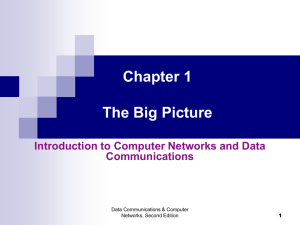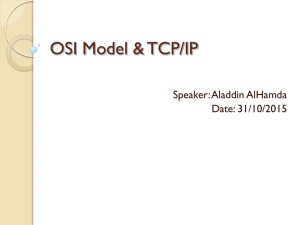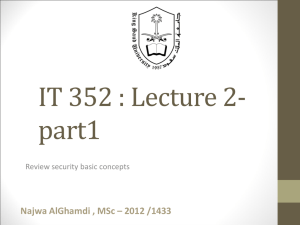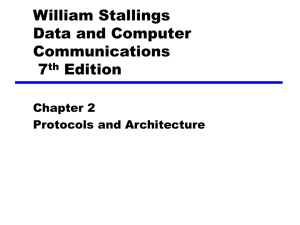OSI Model & TCP/IP
advertisement
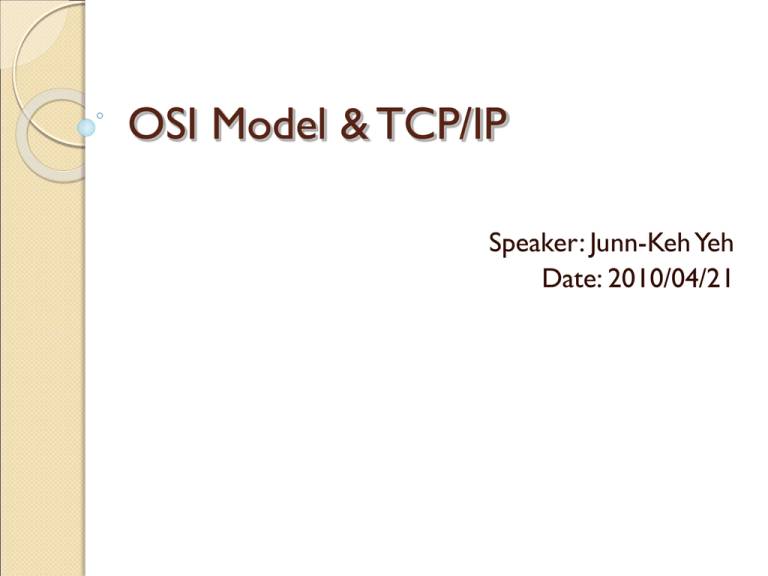
OSI Model & TCP/IP Speaker: Junn-Keh Yeh Date: 2010/04/21 Out Line Introduction OSI OSI History OSI Layers Introduction TCP/IP TCP/IP Layers Layering Considered Harmful? 2 Introduction OSI The Open System Interconnection Reference Model (OSI Reference Model or OSI Model) is an abstract description for layered communications and computer network protocol design. It divides network architecture into seven layers which, from top to bottom, are the Application, Presentation, Session, Transport, Network, Data Link, and Physical Layers. It is therefore often referred to as the OSI Seven Layer Model. 3 OSI History In 1978, the International Standars Organization (ISO) began to develop its OSI framework architecture. OSI has two major components: an abstract model of networking, called the Basic Reference Model or seven-layer model, and a set of specific protocols. 4 OSI History The concept of a 7 layer model was provided by the work of Charles Bachman, then of Honeywell. Various aspects of OSI design evolved from experiences with the Advanced Research Projects Agency Network (ARPANET) and the fledgling Internet. 5 OSI Layers OSI Model Data unit Host layers Media layers Data Layer Function 7.Application Network process to application 6. Presentation Data representation, encryption and decryption 5. Session Interhost communication Segments 4.Transport End-to-end connections and reliability, Flow control Packet 3. Network Path determination and logical addressing Frame 2. Data Link Physical addressing Bit 1. Physical Media, signal and binary transmission Going from layer 1 to 7: Please Do Not Throw Sausage Pizza Away Going from layer 7 to 1: All People Seem To Need Data Processing 6 Layer1: Physical Layer The Physical Layer defines the electrical and physical specifications for devices. In particular, it defines the relationship between a device and a physical medium. This includes the layout of pin, voltages, cable specification, hubs, repeaters, network adapters, host bus adapters, and more. 7 Layer1: Physical Layer The major functions and services performed by the Physical Layer are: ◦ Establishment and termination of a connection to a communication medium. ◦ Participation in the process whereby the communication resources are effectively shared among multiple users. For example, flow control. ◦ Modulation, or conversion between the representation of digital data in user equipment and the corresponding signals transmitted over a communications channel. These are signals operating over the physical cabling (such as copper and optical fiber) or over a radio link. 8 Layer1: Physical Layer con. The same applies to local-area networks, such as Ethernet, token ring , FDDI(Fiber Distributed Data Interface), ITU-T( International Telecommunication Union Telecommunication Standardization Sector) G.hn and IEEE802.1I. Personal area networks such as Bluetooth and IEEE 802.15.4. 9 Layer 2: Data Link Layer The Data Link Layer provides the functional and procedural means to transfer data between network entities and to detect and possibly correct errors that may occur in the Physical Layer. Originally, this layer was intended for pointto-point and point-to-multipoint media, characteristic of wide area media in the telephone system. The data link layer is divided into two sublayers by IEEE. 10 Layer 2: Data Link Layer One is Media Access Control (MAC) and another is Logical Link Control (LLC). Mac is lower sub-layer, and it defines the way about the media access transfer, such as CSMA/CD/CA(Carrier Sense Multiple Access/Collision Detection/Collision Avoidance) LLC provides data transmission method in different network. It will re-package date and add a new header. 11 Layer 3: Network Layer The Network Layer provides the functional and procedural means of transferring variable length data sequences from a source to a destination via one or more networks, while maintaining the quality of service requested by the Transport Layer. 12 Layer 3: Network Layer The Network Layer performs ◦ network routing functions, ◦ perform fragmentation and reassembly, ◦ report delivery errors. Routers operate at this layer—sending data throughout the extended network and making the Internet possible. 13 Layer 4: Transport Layer The Transport Layer provides transparent transfer of data between end users, providing reliable data transfer services to the upper layers. The Transport Layer controls the reliability of a given link through flow control, segmentation/desegmentation, and error control. 14 Layer 4: Transport Layer Feature Name TP0 TP1 TP2 TP3 TP4 Connection oriented network Yes Yes Yes Yes Yes Connectionless network No No No No Yes Concatenation and separation No Yes Yes Yes Yes Segmentation and reassembly Yes Yes Yes Yes Yes Error Recovery No Yes No Yes Yes Reinitiate connection (if an excessive number of PDUs are unacknowledged) No Yes No Yes No multiplexing and demultiplexing over a single virtual circuit No No Yes Yes Yes Explicit flow control No No Yes Yes Yes Retransmission on timeout No No No No Yes Reliable Transport Service No Yes No Yes Yes 15 Layer 5: Session Layer The Session Layer controls the dialogues (connections) between computers. It establishes, manages and terminates the connections between the local and remote application. It provides for full-duplex, half-duplex, or simplex operation, and establishes checkpointing, adjournment, termination, and restart procedures. 16 Layer 5: Session Layer The OSI model made this layer responsible for graceful close of sessions, which is a property of the Transmission Control Protocol, and also for session check pointing and recovery, which is not usually used in the Internet Protocol Suite. The Session Layer is commonly implemented explicitly in application environments that use remote procedure calls. 17 Layer 6: Presentation Layer The Presentation Layer establishes a context between Application Layer entities, in which the higher-layer entities can use different syntax and semantics, as long as the presentation service understands both and the mapping between them. This layer provides independence from differences in data representation (e.g., encryption) by translating from application to network format, and vice versa. This layer formats and encrypts data to be sent across a network, providing freedom from compatibility problems. It is sometimes called the syntax layer. 18 Layer 7: Application Layer The application layer is the OSI layer closest to the end user, which means that both the OSI application layer and the user interact directly with the software application. Application layer functions typically include: ◦ identifying communication partners, ◦ determining resource availability, ◦ synchronizing communication. 19 Layer 7: Application Layer Identifying communication partners ◦ Determines the identity and availability of communication partners for an application with data to transmit. Determining resource availability ◦ Decide whether sufficient network or the requested communication exist. Synchronizing communication ◦ All communication between applications requires cooperation that is managed by the application layer. 20 Layer 7: Application Layer Some examples of application layer implementations include ◦ Hypertext Transfer Protocol (HTTP) ◦ File Transfer Protocol (FTP) ◦ Simple Mail Transfer Protocol (SMTP) 21 OSI Feature Open system standards over the world Rigorously defined structured, hierarchical network model Complete description of the function Provide standard test procedures 22 Introduction TCP/IP The Internet Protocol Suite (commonly known as TCP/IP) is the set of communications protocols used for the Internet and other similar networks. It is named from two of the most important protocols in it: ◦ the Transmission Control Protocol (TCP) and ◦ the Internet Protocol (IP), which were the first two networking protocols defined in this standard. 23 TCP/IP Layers OSI Application Layer Presentation Layer Session Layer TCP/IP Application Layer TELNET, FTP, SMTP, POP3, SNMP, NNTP, DNS,NIS, NFS, HTTP, ... Transport Layer Transport Layer Network Layer Internet Layer Data Link Layer Physical Layer TCP , UDP , ... IP , ICMP, ARP, RARP, ... Link Layer FDDI, Ethernet, ISDN, X.25,... 24 TCP/IP Stack 25 TCP/IP Encapsulation 26 TCP/IP Some Protocol Layer Application Transport Protocol DNS,TFTP,TLS/SSL, FTP, Gopher, HTTP, IMAP, IRC, NNTP, POP3, SIP, SMTP, SMPP, SNMP, SSH,Telnet, Echo, RTP, PNRP, rlogin, ENRP Routing protocols like BGP and RIP which run over TCP/UDP, may also be considered part of the Internet Layer. TCP, UDP, DCCP, SCTP, IL, RUDP, RSVP IP (IPv4, IPv6), ICMP, IGMP, and ICMPv6 Internet Link OSPF for IPv4 was initially considered IP layer protocol since it runs per IP-subnet, but has been placed on the Link since RFC 2740. ARP, RARP, OSPF (IPv4/IPv6), IS-IS, NDP 27 Why Layering Considered Harmful? In the data networking context structured layering implies that the functions of each layer are carried out completely before the protocol data unit is passed to the next layer. This means that the optimization of each layer has to be done separately. Such ordering constraints are in conflict with efficient implementation of data manipulation functions. 28 Why Layering Considered Harmful? As a result of inter-layer dependencies, increased layering can quickly lead to violation of the Simplicity Principle. Industry experience has taught us that increased layering frequently increases complexity and hence leads to increases in OPEX(Operating Expense營運成本), as is predicted by the Simplicity Principle. It is always possible to agglutinate multiple separate problems into a single complex interdependent solution. In most cases this is a bad idea. 29 References http://en.wikipedia.org/wiki/OSI_model http://en.wikipedia.org/wiki/Internet_Prot ocol_Suite http://lips.lis.ntu.edu.tw/YTCHIANG/STU DY/others/tcpiposi.htm RFC 3439 30



